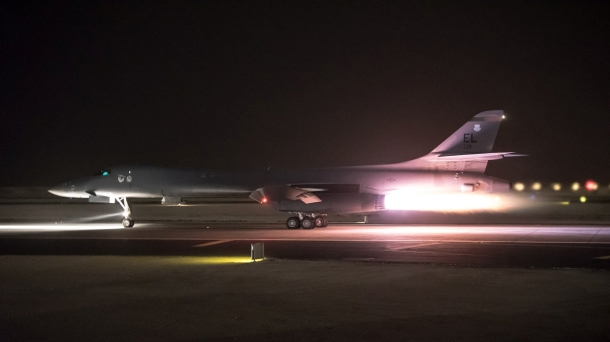
On the evening of 9 April 2018, Israeli jets shelled the T4 military airfield east of Homs, killing two Iranian military personnel and destroying military installations. A few days later, at dawn on 14 April 2018, the United States, joined by the United Kingdom and France, launched airstrikes on targets thought to be directly linked to the development and storage of chemical weapons. These two incursions barely a week apart further complicated the already byzantine Syrian conflict and spurred talk of a new cold war between Russia and the West.
Unexpected and largely uncovered by the media, including state media in Syria, the Israeli strike targeted the T4 military airfield, believed to be a centre for Iranian military experts and Shia militias. Initial reports attributed the strike to the United States, but Lebanese sources later reported that Israeli jets had entered Lebanese airspace shortly before the attack. While the Syrians ignored the attack and the Israelis refused to comment, a Russian statement confirmed Israeli responsibility.
Like past Israeli sorties in Syria, this attack aimed to neutralise perceived Iranian and Hezbollah threats. Iran itself is seen as a strategic threat, and Israeli Prime Minister Benyamin Netanyahu has repeatedly said that his country would not allow it to establish a permanent military presence in Syria. Reports of unprecedented quantities of arms flowing to Hezbollah and perhaps even to Hamas in Gaza only underscore the threat.
In contrast, the US-led strike was widely anticipated. On 7 April 2018, chemical weapons were reportedly used against the opposition holdout in Douma, in eastern Ghouta, killing some 40 people and injuring dozens of others. Although Bashar al-Assad and Russia denied evidence of any chemical attack and observers speculated about the regime’s motivations, French and U.S. officials affirmed that chlorine and another unidentified gas were used.
The Western response was swift and sharp. U.S. President Trump issued immediate threats against the Assad regime and its Russian ally. Having once already struck at the Syrian regime following its use of chemical weapons in Khan Sheikhoun in April 2017, the US threat carried weight, although the scope and objective of a new attack remained unclear. When it came, the 70-minute strike targeted three alleged chemical weapons sites, inflicting major damage on the targets with no reported loss of life.
But despite the international uproar in the run-up to the strike, it may prove to be merely a blip. It is now clear that the United States did not seek to alter the balance of power in Syria or signal a shift of its Syria policy. Most of the Gulf States and Europe expressed support for the action. Despite Russian remonstrations before and after the strike, it did not follow through on threats to decisively meet any attack on the Syrian regime. If anything, the tripartite strike exposed the hollowness of claims of an imminent new cold war. While Russia can act as a thorn in the West’s side, it no longer has the capacities for a sustained confrontation. Any real clash with Western powers in Syria would be a costly drain on its resources, already stretched by successive rounds of sanctions.
Despite fervent Syrian opposition hopes, the Trump administration shows no signs of adopting a policy of regime change in Syria. In fact, barely two weeks before the strike, on 29 March 2018, Trump surprised his own State and Defense Departments when he declared in Ohio that he would soon withdraw all 2,000–3,000 U.S. troops deployed in eastern Syria. Though his aides appear to have convinced him to think twice about full withdrawal, he still seems intent on leaving Syria. The U.S. military presence in the country, as well as providing support for the fight against the Islamic State, also seeks, crucially, to thwart any Iranian attempt to secure a supply line from western Iran to the Mediterranean.
If Trump follows through on his promise, Iran will be freer to cement its toehold in Syria. Israel would undoubtedly take this as further provocation. Although Russia would likely attempt to defuse tensions—as indicated by Putin’s call to Netanyahu immediately after the Israeli strike on the T4 base—it may not be able to prevent a direct confrontation if Iran acts with the acquiescence of the Assad regime.
The immediate danger in Syria, then, is not a reprise of the old conflict between two nuclear-armed foes, but a more direct confrontation between Israel and Iran. While Israel has little interest in regime change and no stake in protecting the Syrian people, it is deeply hostile toward the prospect of its principal regional adversary becoming entrenched next door, and it will no doubt act to prevent this.
This is a summary of a policy brief originally written in Arabic, available here:
http://studies.aljazeera.net/ar/positionestimate/2018/04/180417082130203.html